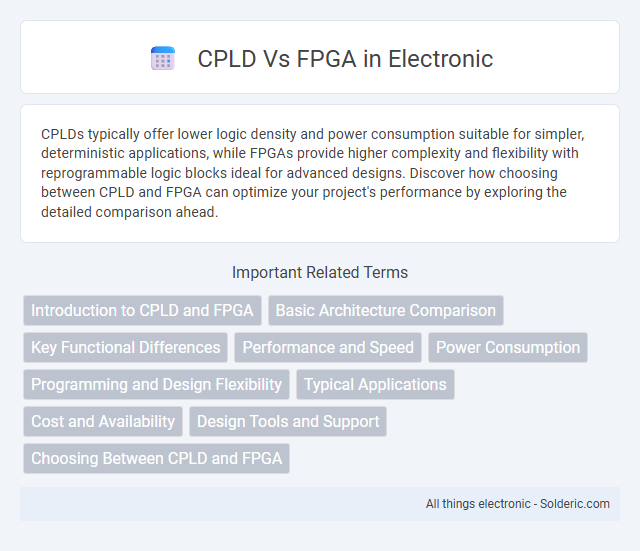CPLDs typically offer lower logic density and power consumption suitable for simpler, deterministic applications, while FPGAs provide higher complexity and flexibility with reprogrammable logic blocks ideal for advanced designs. Discover how choosing between CPLD and FPGA can optimize your project's performance by exploring the detailed comparison ahead.
Comparison Table
| Feature | CPLD (Complex Programmable Logic Device) | FPGA (Field Programmable Gate Array) |
|---|---|---|
| Architecture | Non-volatile, fixed logic blocks | Volatile, configurable logic blocks with LUTs |
| Logic Capacity | Lower, limited gates (thousands) | Higher, millions of gates |
| Power Consumption | Lower static power consumption | Higher dynamic power consumption |
| Configuration | One-time programmable or flash-based, retains configuration on power off | Requires external configuration on power up (volatile) |
| Speed | Faster interconnect due to fixed architecture | Higher processing speed with complex designs possible |
| Cost | Lower cost for simple logic functions | Higher cost but suitable for complex applications |
| Use Cases | Simple glue logic, small control circuits | Complex signal processing, embedded systems, DSP |
Introduction to CPLD and FPGA
CPLDs (Complex Programmable Logic Devices) offer a simpler architecture with predictable timing, ideal for control-oriented applications requiring fewer logic gates and non-volatile memory. FPGAs (Field-Programmable Gate Arrays) provide high logic density, extensive programmable interconnects, and versatile functionality, suited for complex digital signal processing and high-performance computing tasks. Both CPLDs and FPGAs enable hardware designs to be digitally programmed, but FPGAs typically deliver greater scalability and flexibility.
Basic Architecture Comparison
CPLDs feature a simpler, non-volatile architecture composed of a fixed array of programmable logic blocks and interconnects ideal for implementing combinational logic with predictable timing. FPGAs offer a more complex architecture with a large number of configurable logic blocks (CLBs), embedded memory, and programmable interconnects, enabling high-density and flexible designs suitable for complex parallel processing. While CPLDs use macrocells with limited routing resources, FPGAs leverage lookup tables (LUTs) and flip-flops for extensive logic customization and scalability.
Key Functional Differences
CPLDs (Complex Programmable Logic Devices) offer simpler architectures with non-volatile memory, making them ideal for control-oriented tasks and low pin-count designs, whereas FPGAs (Field Programmable Gate Arrays) feature larger, more complex arrays of logic blocks and configurable interconnects, suitable for high-performance parallel processing and custom computing. CPLDs consume less power and have faster start-up times, while FPGAs provide greater flexibility with embedded resources like DSP blocks and memory blocks for advanced signal processing. Your choice depends on whether you prioritize deterministic timing and simplicity (CPLD) or scalability and complexity (FPGA) in your application.
Performance and Speed
CPLDs offer faster predictable timing and lower latency, making them ideal for simple control logic and glue logic applications requiring immediate response. FPGAs provide significantly higher performance and speed for complex processing tasks due to their abundant logic resources and advanced parallel architecture. Your choice depends on whether you prioritize deterministic timing or the capacity for high-speed, intricate computations.
Power Consumption
CPLDs generally consume less power than FPGAs due to their simpler architecture and lower gate count, making them ideal for low-power applications. FPGAs, with their complex and flexible logic blocks, tend to have higher dynamic and static power consumption, especially in high-density designs. Power management techniques and advanced fabrication processes can help reduce FPGA power usage, but CPLDs remain more efficient for stable, low-power tasks.
Programming and Design Flexibility
CPLDs (Complex Programmable Logic Devices) offer simpler programming models with fixed architecture, making them suitable for straightforward logic designs and faster configuration times. FPGAs (Field-Programmable Gate Arrays) provide extensive design flexibility through vast arrays of configurable logic blocks and interconnects, supporting complex, high-performance applications and reprogrammability for iterative design changes. The choice between CPLD and FPGA hinges on project complexity, with CPLDs favoring deterministic designs and FPGAs enabling scalable, multidimensional architecture customization.
Typical Applications
CPLDs are typically used in control-oriented applications such as simple logic replacement, glue logic, and state machine control where low pin count and simple architecture provide cost-effective solutions. FPGAs excel in complex, high-density applications like digital signal processing, embedded systems, and high-speed data processing due to their vast programmable logic blocks and flexibility. Both devices are crucial in prototyping and hardware acceleration but differ significantly in scalability and capability based on application demands.
Cost and Availability
CPLDs generally have lower initial costs and are readily available for small to medium-scale applications, making them ideal for cost-sensitive projects with moderate complexity. FPGAs, while more expensive per unit, offer higher integration and performance, but their prices have decreased due to mass production, improving accessibility for complex designs. Both devices have broad market availability, but CPLDs tend to be more accessible in smaller quantities, whereas FPGAs are optimized for high-volume, high-performance applications.
Design Tools and Support
Design tools for CPLD (Complex Programmable Logic Device) are typically simpler and oriented towards smaller, less complex logic implementations, with manufacturers like Xilinx providing platforms such as ISE tailored for CPLD development. FPGA (Field-Programmable Gate Array) design tools, such as Xilinx Vivado and Intel Quartus, support more complex and larger-scale designs, offering advanced synthesis, placement, routing, and simulation features. FPGA toolchains often include extensive IP cores, debugging, and optimization capabilities, providing robust support for diverse applications compared to CPLD tools.
Choosing Between CPLD and FPGA
Choosing between CPLD and FPGA depends on application requirements such as complexity, cost, and power consumption. CPLDs offer deterministic timing and lower power for simpler logic designs with fewer gates, making them ideal for control-oriented tasks. FPGAs provide higher logic density and flexibility for complex algorithms and parallel processing, suited for advanced signal processing and large-scale integrations.
CPLD vs FPGA Infographic

 solderic.com
solderic.com